Retrieving Soil Moisture at the Field Scale from Sentinel-1 Data over a Semi-Arid Mediterranean Agricultural Area
Abstract
1. Introduction
2. Materials
2.1. Study Case
2.2. In Situ Data
2.2.1. Soil Moisture Measurements
2.2.2. Meteorological Data
2.3. Satellite Data
2.3.1. Sentinel-1 SAR Data
2.3.2. Sentinel-2 Optical Data
3. Method
3.1. Preliminary Analysis for Field Selection
3.2. Superficial Soil Moisture Estimation
3.2.1. Change Dectection Method
3.2.2. Inversion Algorithm
4. Results and Discussion
4.1. Field Selection
4.2. Superficial Soil Moisture
Sensitivity Analysis
5. Conclusions and Future Works
Author Contributions
Funding
Acknowledgments
Conflicts of Interest
Appendix A. Superficial Soil Moisture
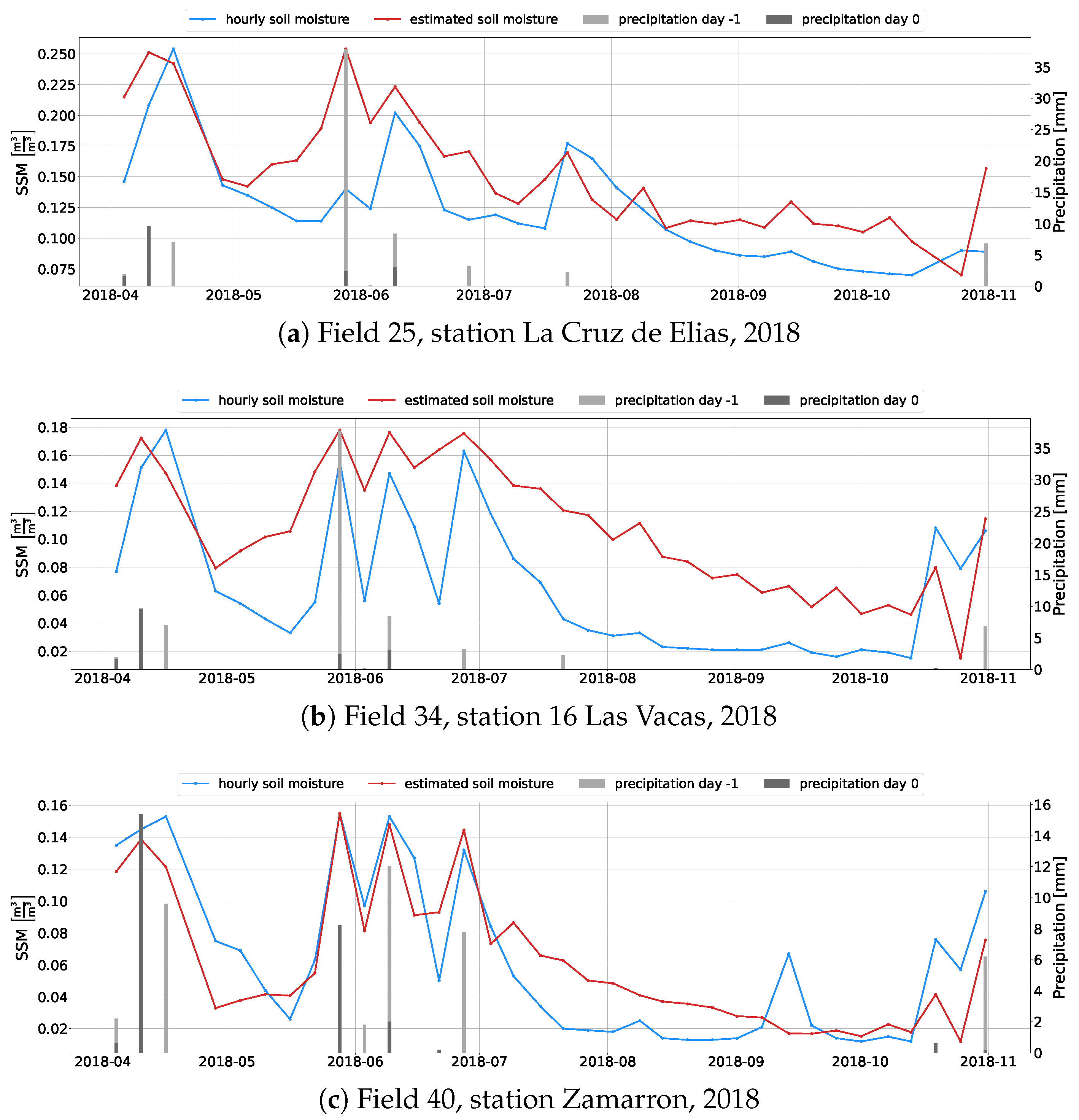
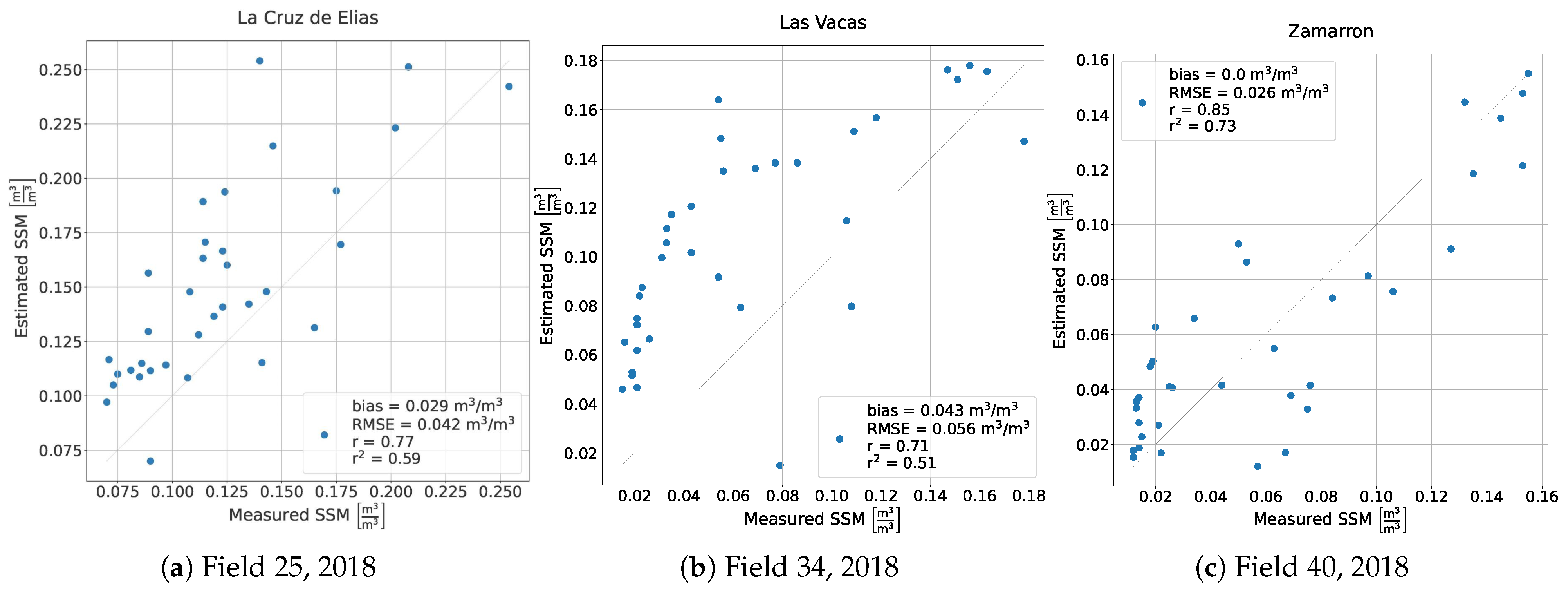

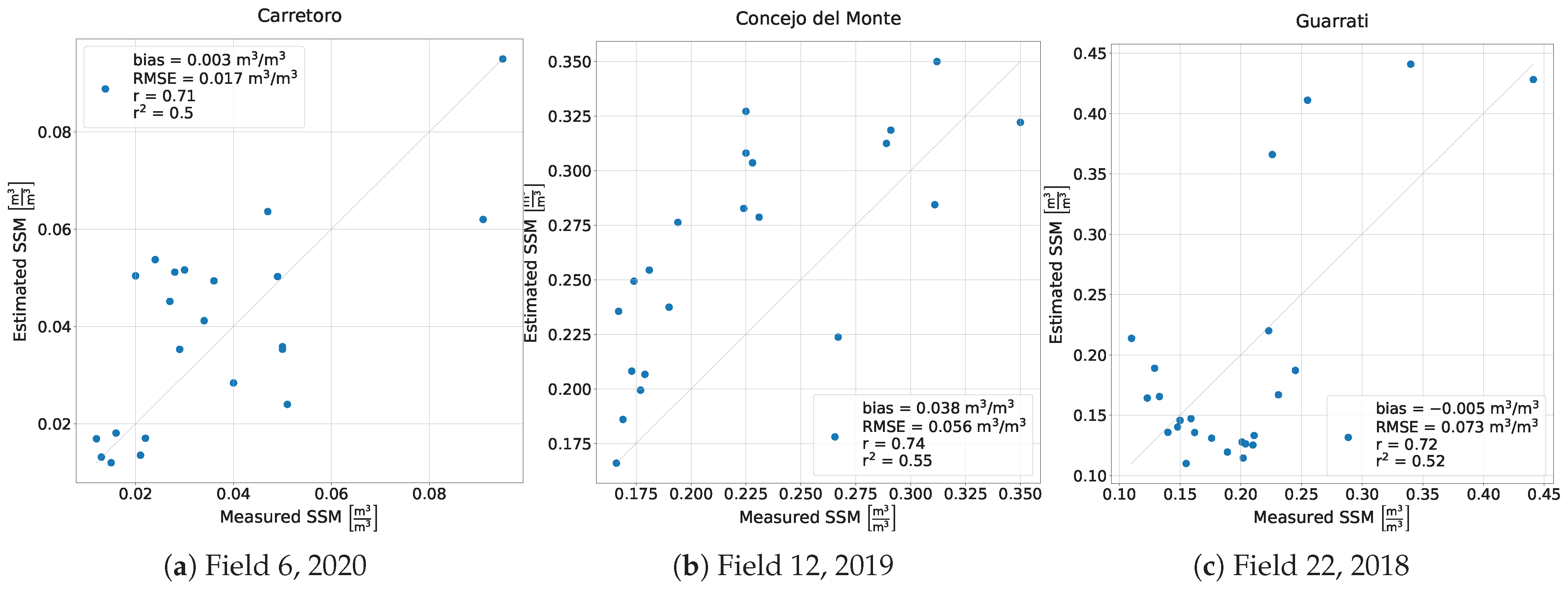
References
- Seneviratne, S.I.; Corti, T.; Davin, E.L.; Hirschi, M.; Jaeger, E.B.; Lehner, I.; Orlowsky, B.; Teuling, A.J. Investigating soil moisture–climate interactions in a changing climate: A review. Earth-Sci. Rev. 2010, 99, 125–161. [Google Scholar] [CrossRef]
- Babaeian, E.; Sadeghi, M.; Jones, S.B.; Montzka, C.; Vereecken, H.; Tuller, M. Ground, Proximal, and Satellite Remote Sensing of Soil Moisture. Rev. Geophys. 2019, 57, 530–616. [Google Scholar] [CrossRef]
- Pasolli, L.; Notarnicola, C.; Bertoldi, G.; Bruzzone, L.; Remelgado, R.; Greifeneder, F.; Niedrist, G.; Chiesa, S.D.; Tappeiner, U.; Zebisch, M. Estimation of Soil Moisture in Mountain Areas Using SVR Technique Applied to Multiscale Active Radar Images at C-Band. IEEE J. Sel. Top. Appl. Earth Obs. Remote Sens. 2015, 8, 262–283. [Google Scholar] [CrossRef]
- Implementation Plan for the Global Observing System for Climate in Support of the UNFCCC; Technical Report WMO/TD No. 1244; Global Climate Observing System: Geneva, Switzerland, 2010; 23p.
- Brocca, L.; Crow, W.T.; Ciabatta, L.; Massari, C.; de Rosnay, P.; Enenkel, M.; Hahn, S.; Amarnath, G.; Camici, S.; Tarpanelli, A.; et al. A Review of the Applications of ASCAT Soil Moisture Products. IEEE J. Sel. Top. Appl. Earth Obs. Remote Sens. 2017, 10, 2285–2306. [Google Scholar] [CrossRef]
- Petropoulos, G.P.; Ireland, G.; Barrett, B. Surface soil moisture retrievals from remote sensing: Current status, products & future trends. Phys. Chem. Earth Parts A/B/C 2015, 83–84, 36–56. [Google Scholar] [CrossRef]
- Srivastava, P.K. Satellite Soil Moisture: Review of Theory and Applications in Water Resources. Water Resour. Manag. 2017, 31, 3161–3176. [Google Scholar] [CrossRef]
- Yu, K.; Han, S.; Bu, J.; An, Y.; Zhou, Z.; Wang, C.; Tabibi, S.; Cheong, J.W. Spaceborne GNSS Reflectometry. Remote Sens. 2022, 14, 1605. [Google Scholar] [CrossRef]
- Kerr, Y.H.; Waldteufel, P.; Richaume, P.; Wigneron, J.P.; Ferrazzoli, P.; Mahmoodi, A.; Bitar, A.A.; Cabot, F.; Gruhier, C.; Juglea, S.E.; et al. The SMOS Soil Moisture Retrieval Algorithm. IEEE Trans. Geosci. Remote Sens. 2012, 50, 1384–1403. [Google Scholar] [CrossRef]
- Chan, S.K.; Bindlish, R.; O’Neill, P.E.; Njoku, E.; Jackson, T.; Colliander, A.; Chen, F.; Burgin, M.; Dunbar, S.; Piepmeier, J.; et al. Assessment of the SMAP Passive Soil Moisture Product. IEEE Trans. Geosci. Remote Sens. 2016, 54, 4994–5007. [Google Scholar] [CrossRef]
- Li, L.; Gaiser, P.W.; Gao, B.C.; Bevilacqua, R.M.; Jackson, T.J.; Njoku, E.G.; Rudiger, C.; Calvet, J.C.; Bindlish, R. WindSat Global Soil Moisture Retrieval and Validation. IEEE Trans. Geosci. Remote Sens. 2010, 48, 2224–2241. [Google Scholar] [CrossRef]
- Wagner, W.; Hahn, S.; Kidd, R.; Melzer, T.; Bartalis, Z.; Hasenauer, S.; Figa-Salda na, J.; de Rosnay, P.; Jann, A.; Schneider, S.; et al. The ASCAT Soil Moisture Product: A Review of its Specifications, Validation Results, and Emerging Applications. Meteorol. Z. 2013, 22, 5–33. [Google Scholar] [CrossRef]
- Kornelsen, K.C.; Coulibaly, P. Advances in soil moisture retrieval from synthetic aperture radar and hydrological applications. J. Hydrol. 2013, 476, 460–489. [Google Scholar] [CrossRef]
- Torres, R.; Snoeij, P.; Geudtner, D.; Bibby, D.; Davidson, M.; Attema, E.; Potin, P.; Rommen, B.; Floury, N.; Brown, M.; et al. GMES Sentinel-1 mission. Remote Sens. Environ. 2012, 120, 9–24. [Google Scholar] [CrossRef]
- Balenzano, A.; Mattia, F.; Satalino, G.; Lovergine, F.P.; Palmisano, D.; Peng, J.; Marzahn, P.; Wegmüller, U.; Cartus, O.; Dąbrowska-Zielińska, K.; et al. Sentinel-1 soil moisture at 1 km resolution: A validation study. Remote Sens. Environ. 2021, 263, 112554. [Google Scholar] [CrossRef]
- Bauer-Marschallinger, B.; Freeman, V.; Cao, S.; Paulik, C.; Schaufler, S.; Stachl, T.; Modanesi, S.; Massari, C.; Ciabatta, L.; Brocca, L.; et al. Toward Global Soil Moisture Monitoring With Sentinel-1: Harnessing Assets and Overcoming Obstacles. IEEE Trans. Geosci. Remote Sens. 2019, 57, 520–539. [Google Scholar] [CrossRef]
- Balenzano, A.; Mattia, F.; Satalino, G.; Davidson, M.W.J. Dense Temporal Series of C- and L-band SAR Data for Soil Moisture Retrieval Over Agricultural Crops. IEEE J. Sel. Top. Appl. Earth Obs. Remote Sens. 2011, 4, 439–450. [Google Scholar] [CrossRef]
- Gao, Q.; Zribi, M.; Escorihuela, M.; Baghdadi, N. Synergetic Use of Sentinel-1 and Sentinel-2 Data for Soil Moisture Mapping at 100 m Resolution. Sensors 2017, 17, 1966. [Google Scholar] [CrossRef]
- Veloso, A.; Mermoz, S.; Bouvet, A.; Toan, T.L.; Planells, M.; Dejoux, J.F.; Ceschia, E. Understanding the temporal behavior of crops using Sentinel-1 and Sentinel-2-like data for agricultural applications. Remote Sens. Environ. 2017, 199, 415–426. [Google Scholar] [CrossRef]
- Zhu, L.; Walker, J.P.; Ye, N.; Rüdiger, C. Roughness and vegetation change detection: A pre-processing for soil moisture retrieval from multi-temporal SAR imagery. Remote Sens. Environ. 2019, 225, 93–106. [Google Scholar] [CrossRef]
- Martínez-Fernández, J.; Ceballos, A. Mean soil moisture estimation using temporal stability analysis. J. Hydrol. 2005, 312, 28–38. [Google Scholar] [CrossRef]
- Dorigo, W.A.; Wagner, W.; Hohensinn, R.; Hahn, S.; Paulik, C.; Xaver, A.; Gruber, A.; Drusch, M.; Mecklenburg, S.; van Oevelen, P.; et al. The International Soil Moisture Network: A data hosting facility for global in situ soil moisture measurements. Hydrol. Earth Syst. Sci. 2011, 15, 1675–1698. [Google Scholar] [CrossRef]
- González-Zamora, Á.; Sánchez, N.; Pablos, M.; Martínez-Fernández, J. CCI soil moisture assessment with SMOS soil moisture and in situ data under different environmental conditions and spatial scales in Spain. Remote Sens. Environ. 2019, 225, 469–482. [Google Scholar] [CrossRef]
- González-Zamora, Á.; Sánchez, N.; Martínez-Fernández, J.; Gumuzzio, Á.; Piles, M.; Olmedo, E. Long-term SMOS soil moisture products: A comprehensive evaluation across scales and methods in the Duero Basin (Spain). Phys. Chem. Earth Parts A/B/C 2015, 83-84, 123–136. [Google Scholar] [CrossRef]
- Estaciones Climatológicas de la Agencia Estatal de Meteorología (AEMET). 2016. Available online: https://www.miteco.gob.es/en/cartografia-y-sig/ide/descargas/otros/default.aspx (accessed on 30 January 2021).
- European Space Agency (ESA). SNAP—ESA Sentinel Application Platform v7.0. Available online: http://step.esa.int/main/ (accessed on 30 January 2021).
- Filipponi, F. Sentinel-1 GRD Preprocessing Workflow. Proceedings 2019, 18, 11. [Google Scholar] [CrossRef]
- Lee, J.S.; Jurkevich, L.; Dewaele, P.; Wambacq, P.; Oosterlinck, A. Speckle filtering of synthetic aperture radar images: A review. Remote Sens. Rev. 1994, 8, 313–340. [Google Scholar] [CrossRef]
- Organismo Autónomo Centro Nacional de Información Geográfica (CNIG). Centro de Descargas. Available online: http://centrodedescargas.cnig.es/CentroDescargas/index.jsp (accessed on 30 March 2021).
- European Space Agency (ESA). Copernicus Open Access Hub. 2020. Available online: https://scihub.copernicus.eu/ (accessed on 30 March 2021).
- Drusch, M.; Bello, U.D.; Carlier, S.; Colin, O.; Fernandez, V.; Gascon, F.; Hoersch, B.; Isola, C.; Laberinti, P.; Martimort, P.; et al. Sentinel-2: ESA’s Optical High-Resolution Mission for GMES Operational Services. Remote Sens. Environ. 2012, 120, 25–36. [Google Scholar] [CrossRef]
- Neteler, M.; Bowman, M.H.; Landa, M.; Metz, M. GRASS GIS: A multi-purpose open source GIS. Environ. Model. Softw. 2012, 31, 124–130. [Google Scholar] [CrossRef]
- Ulaby, F. Radar measurement of soil moisture content. IEEE Trans. Antennas Propag. 1974, 22, 257–265. [Google Scholar] [CrossRef]
- Ullmann, T.; Jagdhuber, T.; Hoffmeister, D.; May, S.M.; Baumhauer, R.; Bubenzer, O. Exploring Sentinel-1 backscatter time series over the Atacama Desert (Chile) for seasonal dynamics of surface soil moisture. Remote Sens. Environ. 2023, 285, 113413. [Google Scholar] [CrossRef]
- Baghdadi, N.; ZribiI, M.; Loumagne, C.; Ansart, P.; Anguela, T. Analysis of TerraSAR-X data and their sensitivity to soil surface parameters over bare agricultural fields. Remote Sens. Environ. 2008, 112, 4370–4379. [Google Scholar] [CrossRef]
- Liu, P.W.; Judge, J.; DeRoo, R.D.; England, A.W.; Bongiovanni, T.; Luke, A. Dominant backscattering mechanisms at L-band during dynamic soil moisture conditions for sandy soils. Remote Sens. Environ. 2016, 178, 104–112. [Google Scholar] [CrossRef]
- Wagner, W.; Lindorfer, R.; Melzer, T.; Hahn, S.; Bauer-Marschallinger, B.; Morrison, K.; Calvet, J.C.; Hobbs, S.; Quast, R.; Greimeister-Pfeil, I.; et al. Widespread occurrence of anomalous C-band backscatter signals in arid environments caused by subsurface scattering. Remote Sens. Environ. 2022, 276, 113025. [Google Scholar] [CrossRef]
- Attema, E.P.W.; Ulaby, F.T. Vegetation modeled as a water cloud. Radio Sci. 1978, 13, 357–364. [Google Scholar] [CrossRef]
- Kumar, K.; Rao, H.P.S.; Arora, M.K. Study of water cloud model vegetation descriptors in estimating soil moisture in Solani catchment. Hydrol. Process. 2014, 29, 2137–2148. [Google Scholar] [CrossRef]
- Prevot, L.; Dechambre, M.; Taconet, O.; Vidal-Madjar, D.; Normand, M.; Gallej, S. Estimating the characteristics of vegetation canopies with airborne radar measurements. Int. J. Remote Sens. 1993, 14, 2803–2818. [Google Scholar] [CrossRef]
- Ester, M.; Kriegel, H.P.; Sander, J.; Xu, X. A density-based algorithm for discovering clusters in large spatial databases with noise. In Proceedings of the Second International Conference on Knowledge Discovery and Data Mining, Portland, OR, USA, 2–4 August 1996; pp. 226–321. [Google Scholar]
- Ouaadi, N.; Jarlan, L.; Ezzahar, J.; Zribi, M.; Khabba, S.; Bouras, E.; Bousbih, S.; Frison, P.L. Monitoring of wheat crops using the backscattering coefficient and the interferometric coherence derived from Sentinel-1 in semi-arid areas. Remote Sens. Environ. 2020, 251, 112050. [Google Scholar] [CrossRef]
- Hachani, A.; Ouessar, M.; Paloscia, S.; Santi, E.; Pettinato, S. Soil moisture retrieval from Sentinel-1 acquisitions in an arid environment in Tunisia: Application of Artificial Neural Networks techniques. Int. J. Remote Sens. 2019, 40, 9159–9180. [Google Scholar] [CrossRef]
- Paloscia, S.; Santi, E.; Fontanelli, G.; Montomoli, F.; Brogioni, M.; Macelloni, G.; Pampaloni, P.; Pettinato, S. The Sensitivity of Cosmo-SkyMed Backscatter to Agricultural Crop Type and Vegetation Parameters. IEEE J. Sel. Top. Appl. Earth Obs. Remote Sens. 2014, 7, 2856–2868. [Google Scholar] [CrossRef]
- Anguela, T.; Zribi, M.; Baghdadi, N.; Loumagne, C. Analysis of Local Variation of Soil Surface Parameters With TerraSAR-X Radar Data Over Bare Agricultural Fields. IEEE Trans. Geosci. Remote Sens. 2010, 48, 874–881. [Google Scholar] [CrossRef]

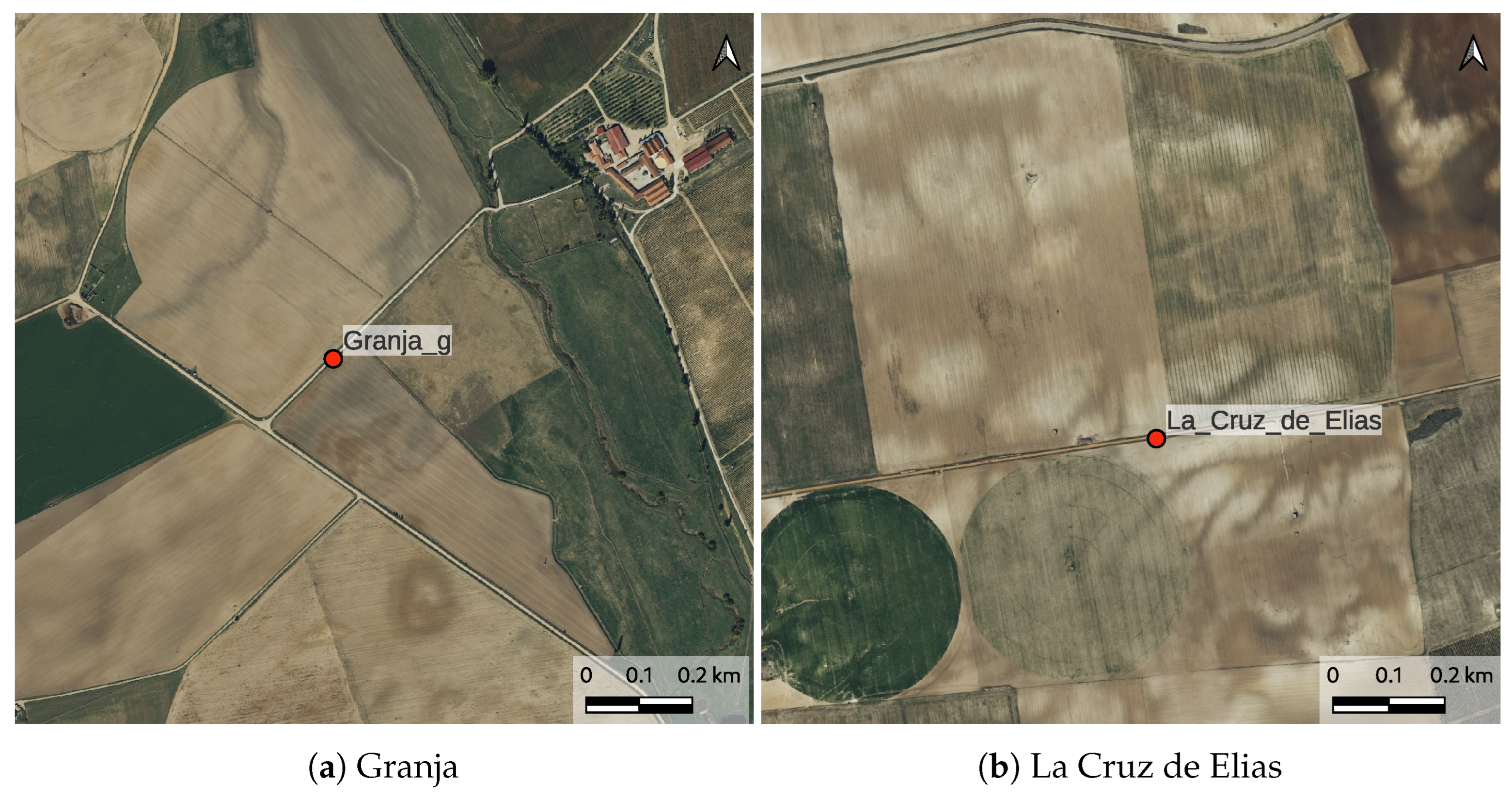
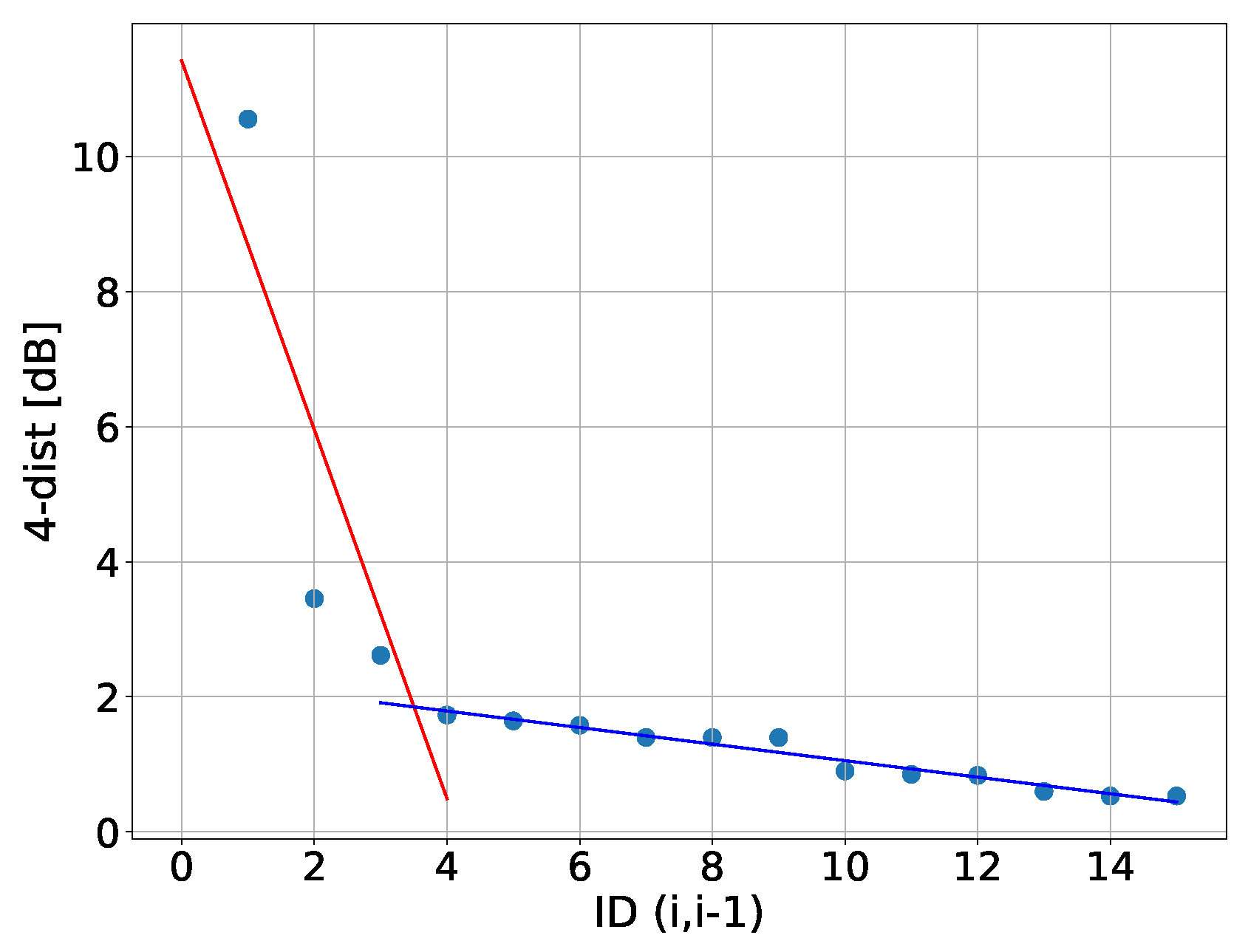
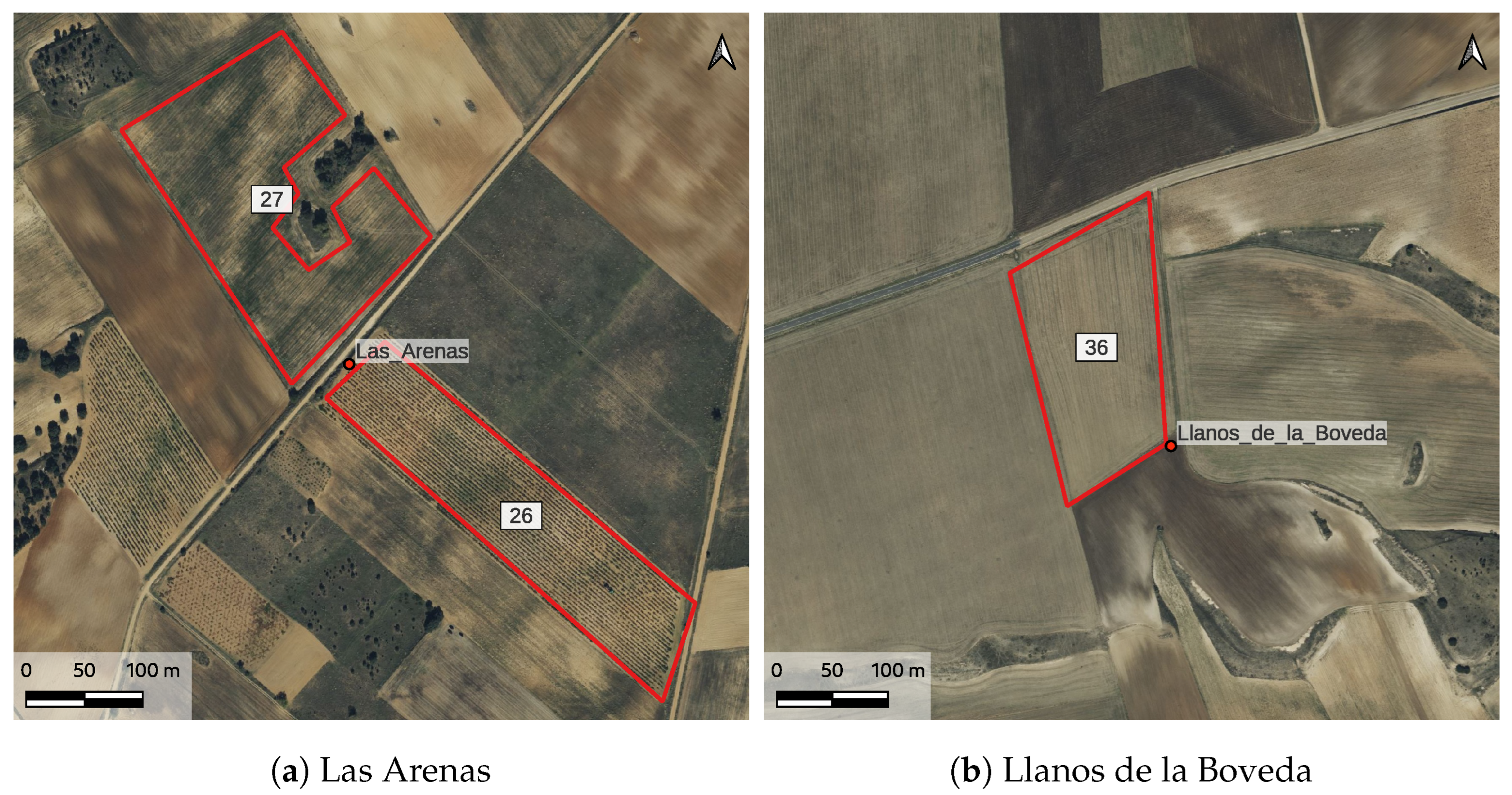
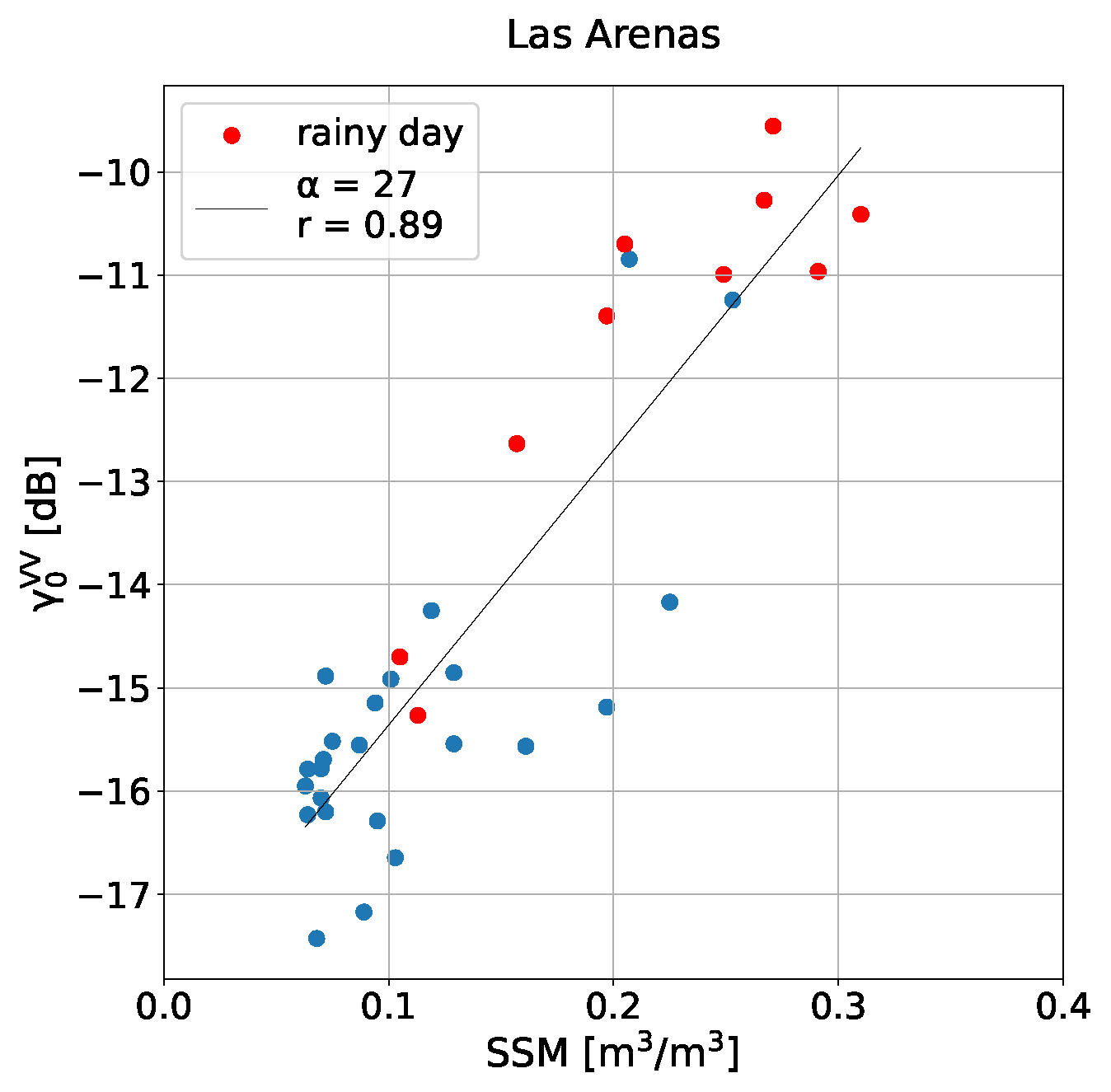
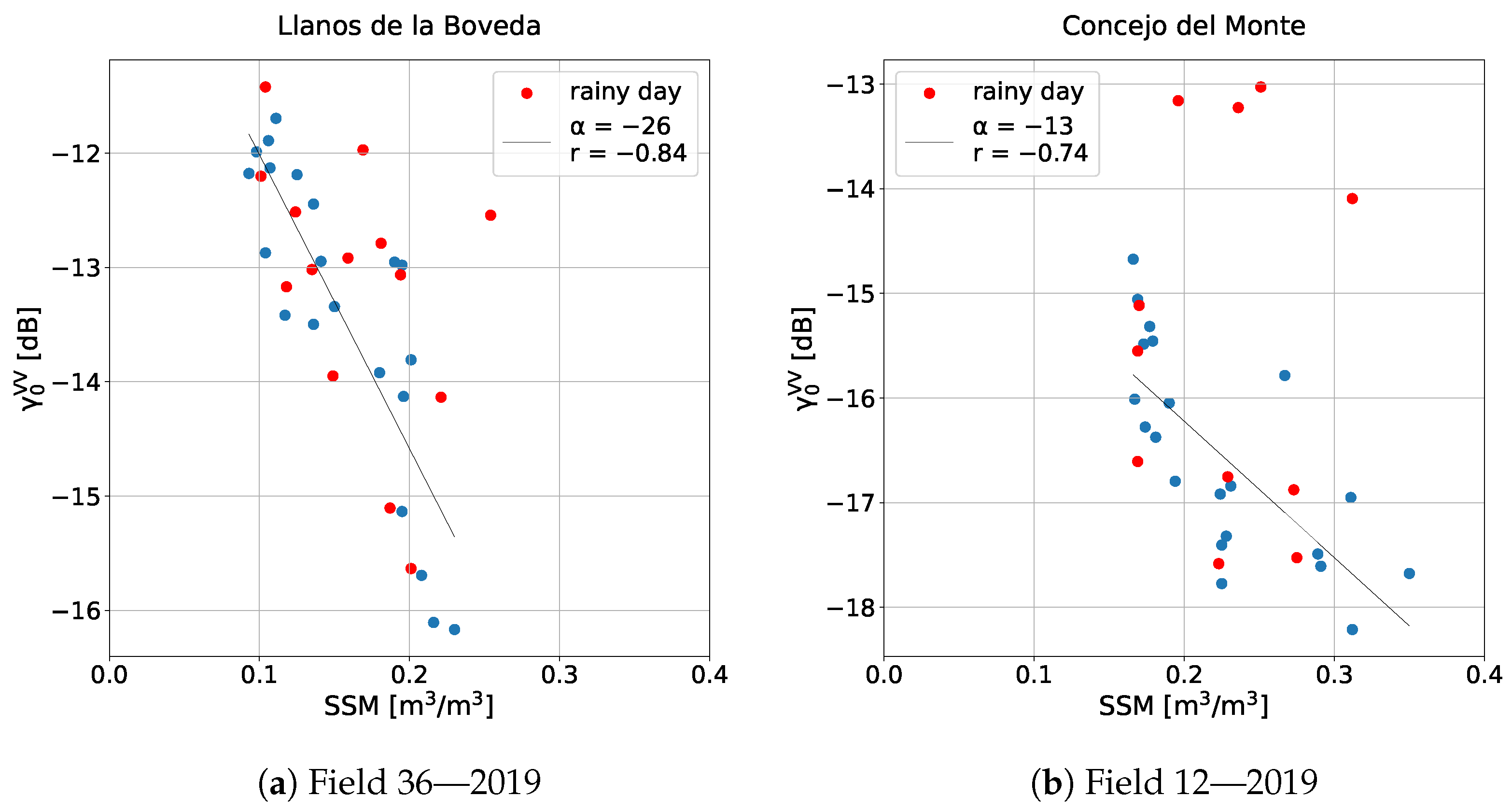
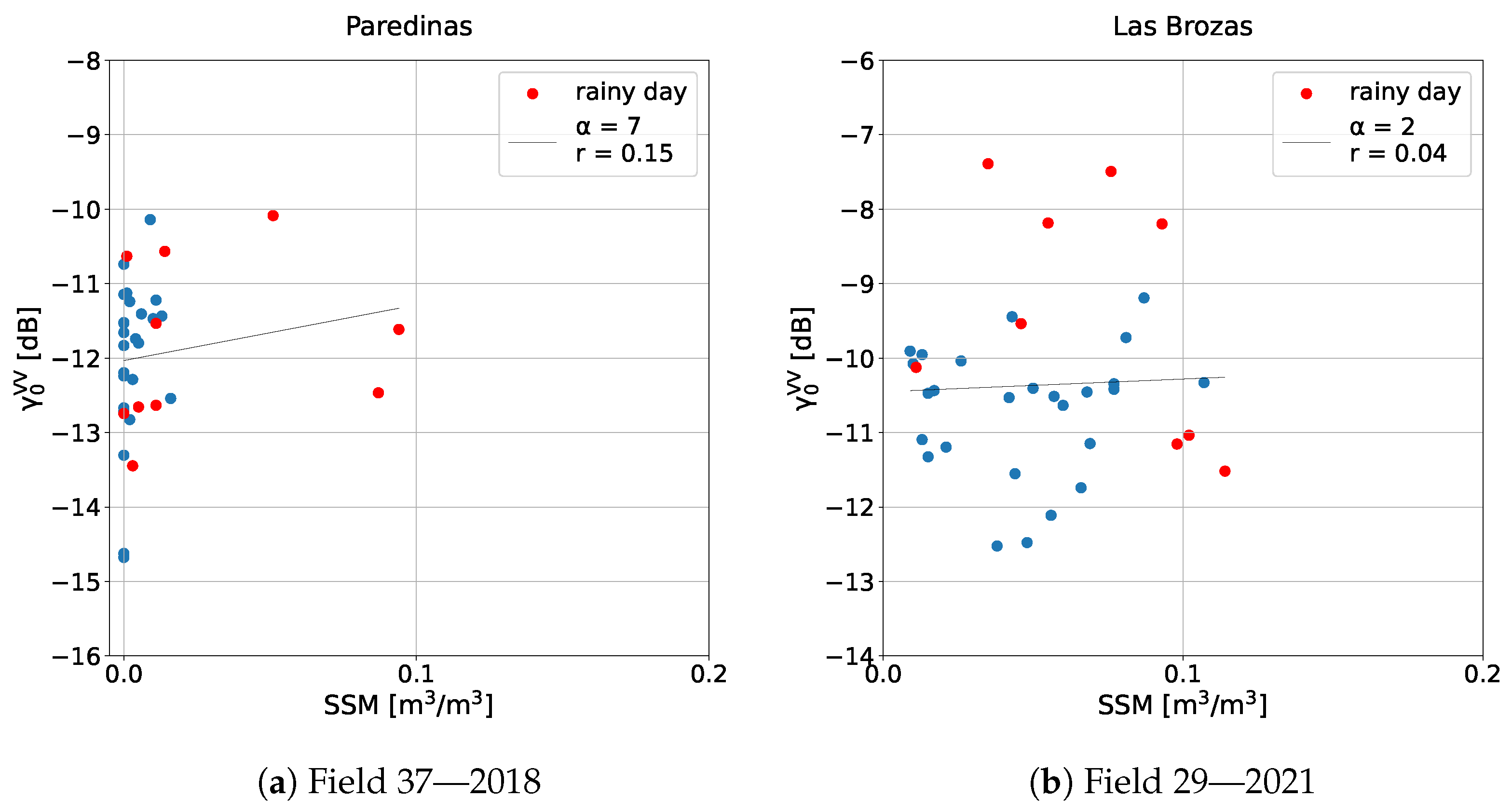


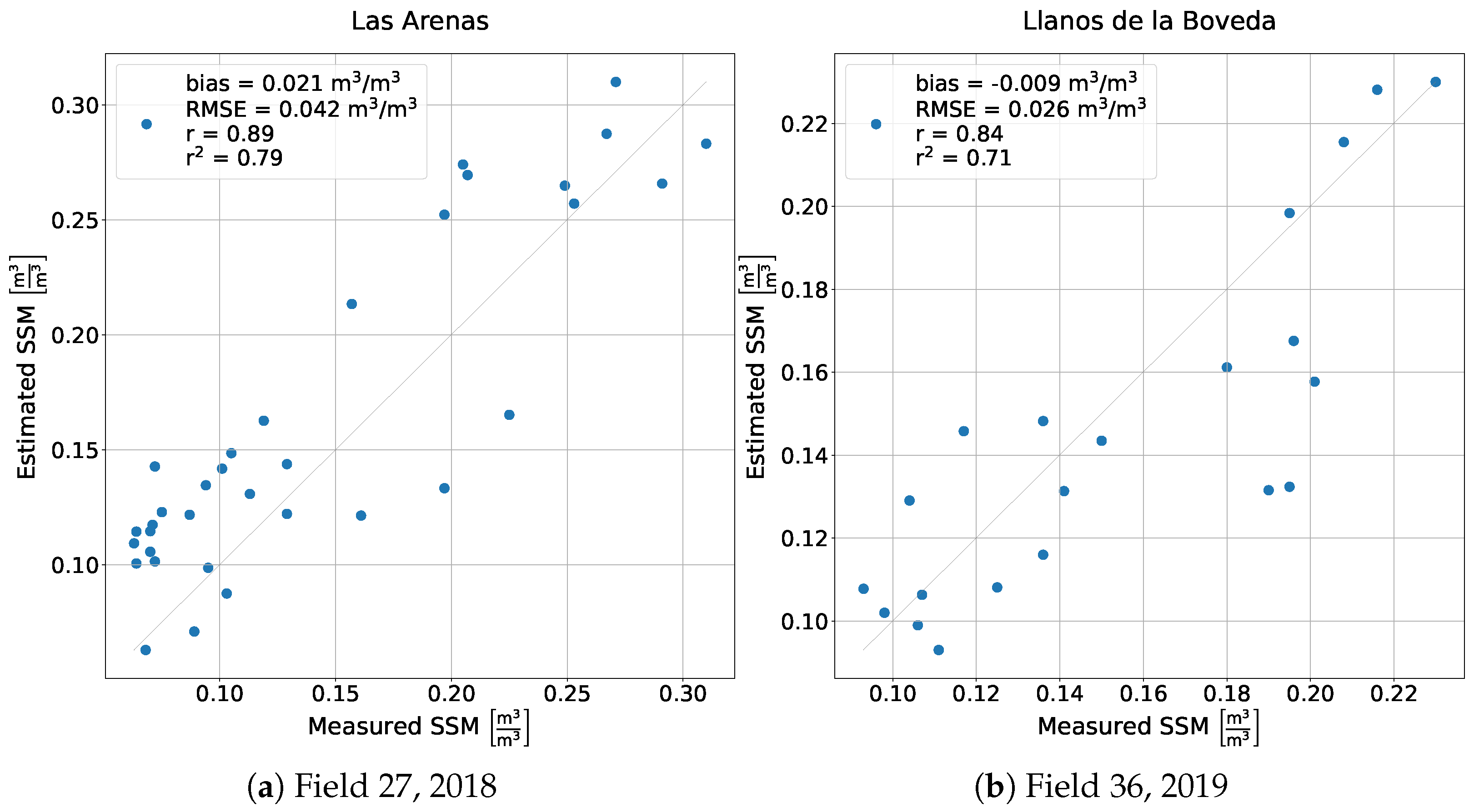
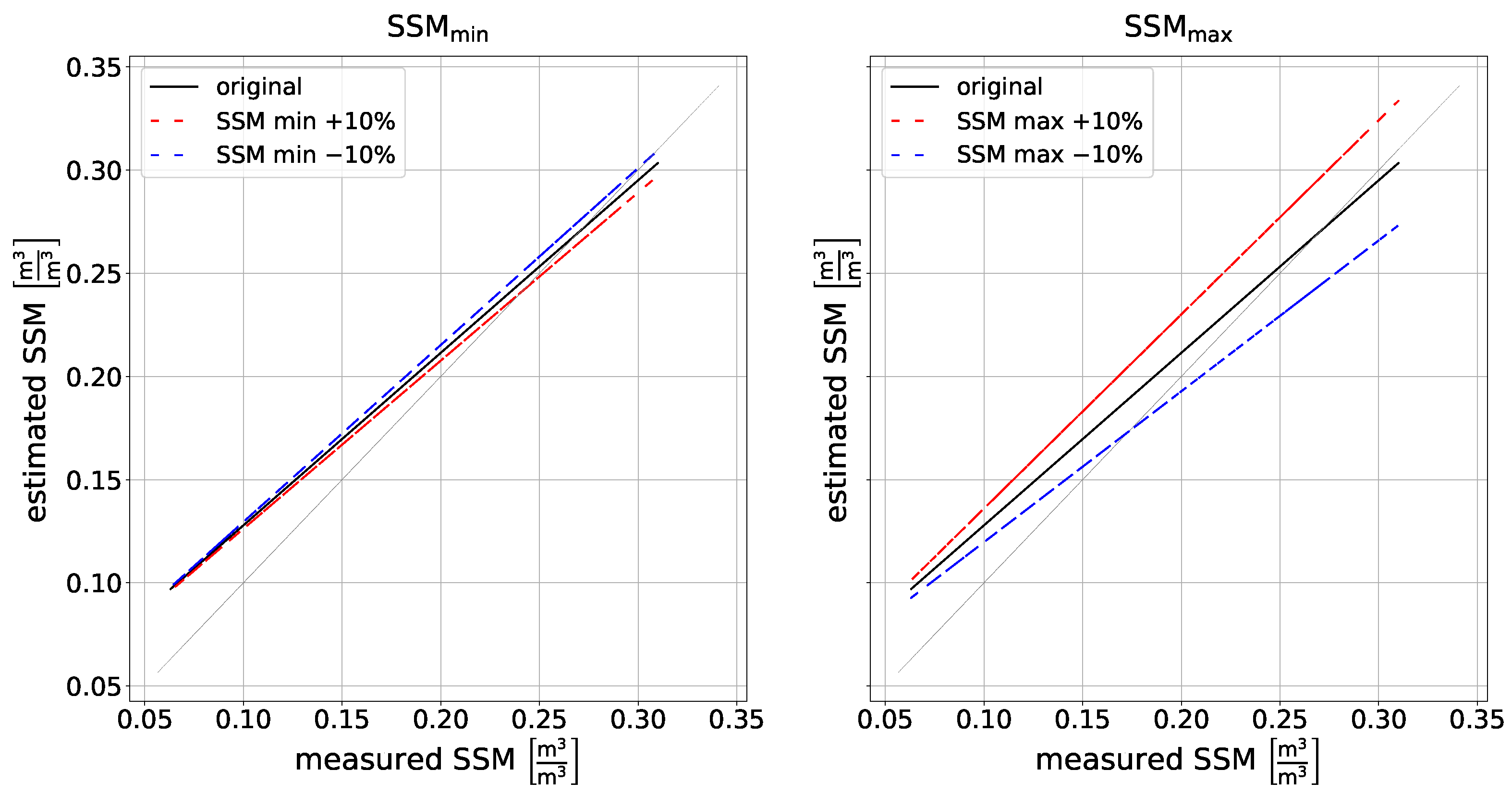
| Study Period | N° of Images | Level Product | Polarization | Relative Orbit n° | Incidence Angle | Relative Orbit |
|---|---|---|---|---|---|---|
| 2018–2021 | 139 | GRD HR | VV, VH | 154, 74 | 30.6–46.5 | Desc., Asc. |
| Station Name | Crop | Field ID | Year | bias [] | rsme [] | r | ||
|---|---|---|---|---|---|---|---|---|
| Canizal | Irrigated | 1 | 2018 | + | 0.032 | 0.067 | 0.50 | 0.25 |
| 2021 | + | −0.021 | 0.054 | 0.59 | 0.35 | |||
| Carretoro | Rainfed cereal | 6 | 2019 | − | 0.004 | 0.007 | 0.50 | 0.25 |
| 2020 | − | 0.003 | 0.017 | 0.71 | 0.50 | |||
| Casa Periles | Rainfed cereal | 11 | 2018 | + | 0.022 | 0.049 | 0.53 | 0.28 |
| Concejo del Monte | Rainfed cereal | 12 | 2019 | − | 0.038 | 0.056 | 0.74 | 0.55 |
| 2020 | − | 0.015 | 0.059 | 0.63 | 0.39 | |||
| El Tomillar | Vineyard | 16 | 2021 | − | 0.009 | 0.018 | 0.69 | 0.48 |
| Granja | Rainfed cereal | 41 | 2018 | + | 0.058 | 0.082 | 0.59 | 0.34 |
| 2020 | + | 0.060 | 0.081 | 0.62 | 0.38 | |||
| Guarrati | Forest/Pastures | 22 | 2018 | − | −0.005 | 0.073 | 0.72 | 0.52 |
| La Cruz de Elias | Rainfed cereal | 25 | 2018 | + | 0.029 | 0.042 | 0.77 | 0.59 |
| Las Arenas | Vineyard | 26 | 2019 | − | 0.030 | 0.052 | 0.67 | 0.45 |
| 2020 | − | 0.020 | 0.045 | 0.54 | 0.29 | |||
| 27 | 2018 | + | 0.021 | 0.042 | 0.89 | 0.79 | ||
| Las Vacas | Rainfed cereal | 33 | 2018 | − | 0.017 | 0.033 | 0.56 | 0.31 |
| 34 | 2018 | + | 0.043 | 0.056 | 0.71 | 0.51 | ||
| Las Victorias | Rainfed cereal | 35 | 2020 | + | 0.005 | 0.023 | 0.68 | 0.46 |
| Llanos de la Boveda | Rainfed cereal | 36 | 2019 | − | −0.009 | 0.026 | 0.84 | 0.71 |
| Zamarron | Rainfed cereal | 39 | 2018 | − | 0.018 | 0.030 | 0.66 | 0.43 |
| 2020 | − | 0.007 | 0.025 | 0.67 | 0.44 | |||
| 40 | 2018 | + | 0.000 | 0.026 | 0.85 | 0.73 | ||
| 2019 | − | −0.010 | 0.025 | 0.66 | 0.43 | |||
| 2020 | − | 0.010 | 0.028 | 0.59 | 0.35 |
| Station Name | Field ID | Year | bias [] | RMSE [] | ||||||
|---|---|---|---|---|---|---|---|---|---|---|
| +10% | −10% | +10% | −10% | +10% | −10% | +10% | −10% | |||
| Carretoro | 6 | 2020 | 0.002 | 0.003 | 0.006 | 0.000 | 0.017 | 0.017 | 0.018 | 0.016 |
| Concejo del Monte | 12 | 2019 | 0.030 | 0.047 | 0.057 | 0.020 | 0.049 | 0.064 | 0.073 | 0.043 |
| Guarrati | 22 | 2018 | −0.008 | −0.002 | 0.006 | −0.016 | 0.070 | 0.075 | 0.083 | 0.065 |
| La Cruz de Elias | 25 | 2018 | 0.025 | 0.032 | 0.040 | 0.017 | 0.040 | 0.045 | 0.053 | 0.033 |
| Las Arenas | 27 | 2018 | 0.018 | 0.023 | 0.034 | 0.008 | 0.040 | 0.043 | 0.051 | 0.037 |
| Las Vacas | 34 | 2018 | 0.042 | 0.043 | 0.053 | 0.033 | 0.055 | 0.057 | 0.065 | 0.048 |
| Llanos de la Boveda | 36 | 2019 | −0.012 | −0.005 | 0.000 | −0.017 | 0.027 | 0.026 | 0.027 | 0.030 |
| Zamarron | 39 | 2018 | −0.001 | 0.000 | 0.005 | −0.005 | 0.026 | 0.026 | 0.027 | 0.027 |
Disclaimer/Publisher’s Note: The statements, opinions and data contained in all publications are solely those of the individual author(s) and contributor(s) and not of MDPI and/or the editor(s). MDPI and/or the editor(s) disclaim responsibility for any injury to people or property resulting from any ideas, methods, instructions or products referred to in the content. |
© 2023 by the authors. Licensee MDPI, Basel, Switzerland. This article is an open access article distributed under the terms and conditions of the Creative Commons Attribution (CC BY) license (https://creativecommons.org/licenses/by/4.0/).
Share and Cite
Graldi, G.; Zardi, D.; Vitti, A. Retrieving Soil Moisture at the Field Scale from Sentinel-1 Data over a Semi-Arid Mediterranean Agricultural Area. Remote Sens. 2023, 15, 2997. https://doi.org/10.3390/rs15122997
Graldi G, Zardi D, Vitti A. Retrieving Soil Moisture at the Field Scale from Sentinel-1 Data over a Semi-Arid Mediterranean Agricultural Area. Remote Sensing. 2023; 15(12):2997. https://doi.org/10.3390/rs15122997
Chicago/Turabian StyleGraldi, Giulia, Dino Zardi, and Alfonso Vitti. 2023. "Retrieving Soil Moisture at the Field Scale from Sentinel-1 Data over a Semi-Arid Mediterranean Agricultural Area" Remote Sensing 15, no. 12: 2997. https://doi.org/10.3390/rs15122997
APA StyleGraldi, G., Zardi, D., & Vitti, A. (2023). Retrieving Soil Moisture at the Field Scale from Sentinel-1 Data over a Semi-Arid Mediterranean Agricultural Area. Remote Sensing, 15(12), 2997. https://doi.org/10.3390/rs15122997






